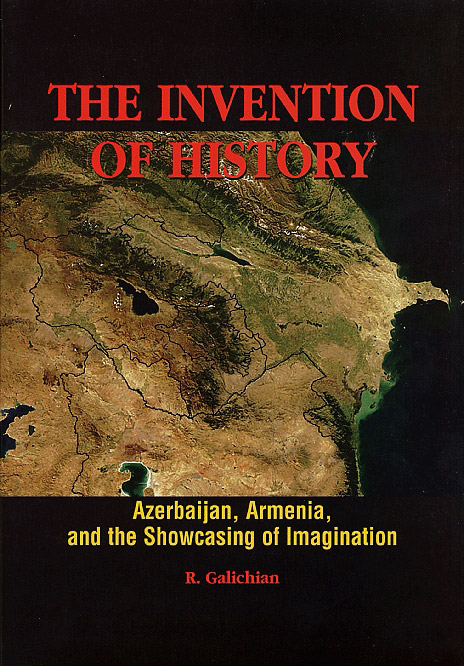Books

The Invention of History: Azerbaijan, Armenia and the Showcasing of Imagination
Gomidas Institute (London) and Printinfo Art Books (Yerevan), 2012,
x + 120 pp., photos, maps and DVD
ISBN 978-1-903656-86-0, hardback
UK£20.00 / US$30.00
To order please contact books@gomidas.org
In early Middle Ages (Caucasian) Albania was a country situated north of the Arax River northwest of Persia, near Armenia and Iberia. During the eleventh to twelfth centuries this Christian country disappeared from maps. After the Arab invasion and the onslaught of the Mongols and Seljuks various Khanates appeared in this area, ruled by local landlords, who paid tribute to the Persians. After the treaty of Turkmanchay (1828) these territories were annexed by Tsarist Russia. In 1918, following the collapse of the Russian Empire, there appeared to the north of the Arax River a new country named Azerbaijan bearing the same name as the Persian province of Azerbaijan across the border.
Since the early 1960s various historians and scientists of this newly founded country have been trying to prove that the population of this land are indigenous to the area and the direct descendants of the Christian Albanians, as well as those of the Mongols and Seljuks. They have also claimed that Armenians arrived in this area in the 1800s. These assertions are then used to claim that the multitude of Christian monuments in this region are Albanian, not Christian Armenian, and therefore part of the Albanian-Azerbaijani-Turkic heritage.
The Azerbaijani authorities also allege that Armenians are destroying Azeri heritage, which is in fact the exact opposite of the truth. Between 1998 and 2005 the actions of Azerbaijani authorities destroyed and completely erased the medieval Armenian cemetery of Julfa. This fact has been recorded from across the border. While Azeri army conscripts have been dumping Armenian carved tombstones into the river, their officials have confirmed that the cemetery was intact and there was no cause to worry. They even claimed that this was an Albanian cemetery, not Armenian. After the destruction was complete, the same authorities now say that there has never been an Armenian cemetery in Julfa, disregarding all existing independent evidence.
This book tries to uncover the truth behind these claims and related allegations and demonstrate the reverse. The paradox, that the Azerbaijan authorities to be the rightful owners of all Christian monuments in the South Caucasus, while destroying most of the same monuments, is difficult to comprehend. No civilised nation would intentionally destroy its own heritage. Could it be that the targeted monuments are not Albanian but irrefutably Armenian?
The book contains chapters discussing the early maps of the area, historical facts, travellers’ reports and other sources proving the existence of Armenians and their culture in these areas. In addition it shows evidence of the fallacy of the Azeri claims regarding the alleged destruction perpetrated by the Armenians. Quite the contrary, it exposes evidence of how the Azeri authorities are busy eradicating all Armenian monuments by any available ways and means.
Also by Rouben Galichian, see Countries South of the Caucasus in Medieval Maps: Armenia, Georgia and Azerbaijan
« Back to books listing
Since the early 1960s various historians and scientists of this newly founded country have been trying to prove that the population of this land are indigenous to the area and the direct descendants of the Christian Albanians, as well as those of the Mongols and Seljuks. They have also claimed that Armenians arrived in this area in the 1800s. These assertions are then used to claim that the multitude of Christian monuments in this region are Albanian, not Christian Armenian, and therefore part of the Albanian-Azerbaijani-Turkic heritage.
The Azerbaijani authorities also allege that Armenians are destroying Azeri heritage, which is in fact the exact opposite of the truth. Between 1998 and 2005 the actions of Azerbaijani authorities destroyed and completely erased the medieval Armenian cemetery of Julfa. This fact has been recorded from across the border. While Azeri army conscripts have been dumping Armenian carved tombstones into the river, their officials have confirmed that the cemetery was intact and there was no cause to worry. They even claimed that this was an Albanian cemetery, not Armenian. After the destruction was complete, the same authorities now say that there has never been an Armenian cemetery in Julfa, disregarding all existing independent evidence.
This book tries to uncover the truth behind these claims and related allegations and demonstrate the reverse. The paradox, that the Azerbaijan authorities to be the rightful owners of all Christian monuments in the South Caucasus, while destroying most of the same monuments, is difficult to comprehend. No civilised nation would intentionally destroy its own heritage. Could it be that the targeted monuments are not Albanian but irrefutably Armenian?
The book contains chapters discussing the early maps of the area, historical facts, travellers’ reports and other sources proving the existence of Armenians and their culture in these areas. In addition it shows evidence of the fallacy of the Azeri claims regarding the alleged destruction perpetrated by the Armenians. Quite the contrary, it exposes evidence of how the Azeri authorities are busy eradicating all Armenian monuments by any available ways and means.
Also by Rouben Galichian, see Countries South of the Caucasus in Medieval Maps: Armenia, Georgia and Azerbaijan